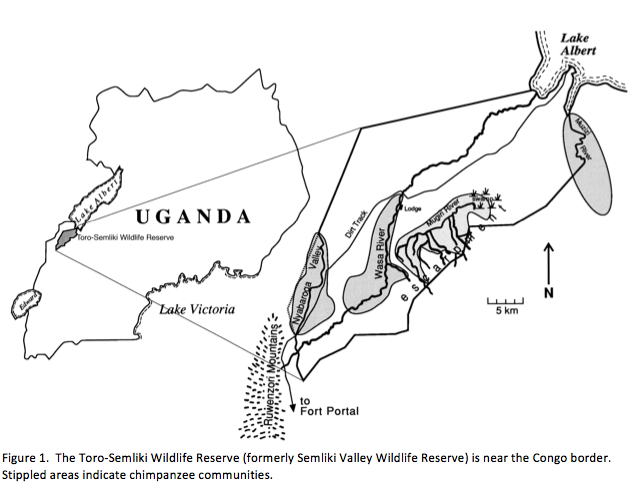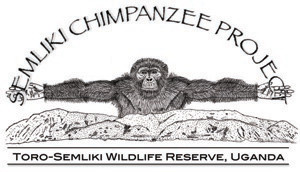Mugiri Community
The chimpanzees of the Mugiri community face four unusual environmental challenges. First, as with all the Semliki chimpanzees, their habitat is dry, sunny and open; most chimpanzees live in forests where the forest floor is damp and dark. Second, their home range is immense, more than 75 sq. km, ranging from the Jogo Jogo swamp to the north to the Wasa River in the south, west to the limits of the Murigi River gallery forest edge, and east to the reserve boundary and beyond. Theirs may be the largest range of any chimpanzee community. Third, their range includes the escarpment, which means chimpanzees range from the rift valley floor up to the very top of the escarpment, more than a 1,000 m higher in elevation. Foraging parties sometimes in move from the rift valley to the top of the escarpment in the same day. Fourth, their habitat is diverse, since it encompasses flooded forest to the north, bushland and wooded grassland on the escarpment to the east, woodland lower on the escarpment, and riverine forests. Their preferred habitat is the riverine forest, which means that in some sense their habitat is one long, narrow forest. Thus resources are widely dispersed, and this puts unusual stresses on the maintenance of social ties.
 Chimpanzees are seen sporadically near the lodge, in the Wasa Riverine forest. We once thought that this was a separate community, since when we encounter these chimpanzees they seem less accepting of human contact than individuals we see in the Mugiri. We have long known that these chimpanzees disappear for months at a time. For years we thought they were disappearing to the west, but after year of tracking we have concluded that they are actually the same chimpanzees we see in the Mugiri, or at least some of them are. Perhaps they are more fearful of humans when they're in the Wasa because it is less common for them to encounter humans there, and because the forest sparser and more open. Still, we are not absolutely certain the Wasa chimpanzees are part of the same community as our study group. They appear rarely enough in the Wasa that we have never gotten a positive ID on any individual there.
Chimpanzees are seen sporadically near the lodge, in the Wasa Riverine forest. We once thought that this was a separate community, since when we encounter these chimpanzees they seem less accepting of human contact than individuals we see in the Mugiri. We have long known that these chimpanzees disappear for months at a time. For years we thought they were disappearing to the west, but after year of tracking we have concluded that they are actually the same chimpanzees we see in the Mugiri, or at least some of them are. Perhaps they are more fearful of humans when they're in the Wasa because it is less common for them to encounter humans there, and because the forest sparser and more open. Still, we are not absolutely certain the Wasa chimpanzees are part of the same community as our study group. They appear rarely enough in the Wasa that we have never gotten a positive ID on any individual there.
The largest party1 in the study area observed so far contained 43 individuals, and with those 43 in sight we could still hear other community members calling some distance away. A rough rule of thumb for estimating community size is that there are twice as many females as males, and about as many juveniles as females. We have identified 29 males so far, but hardly any females. However, if the community contains 30 males, 60 females and 60 juveniles, which our rule of thumb would suggest, the Mugiri community would have 150 individuals, among the largest known.
1Chimpanzee community subgroups are more properly referred to as ‘parties,’ rather than groups.

